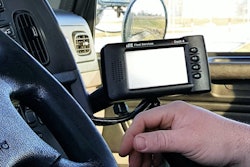If 2017 was the Year of the ELD, 2018 could be the referred to as the Year of Hours of Service. Or, perhaps more fitting, the First Year of Hours of Service, given that the U.S. DOT kicked off a likely multi-year process to overhaul portions of hours of service regulations in August of this year.
In some ways, 2018 is a tale of two halves. The first six months of the year, the ramp-up in enforcement of the electronic logging device and a booming freight market, which brought about surging rates, were the industry’s top-of-mind issues.
The latter months, however, presented a focus on potential economic stumbles, with rates subsiding and concerns about a recession growing. Likewise, the fever around ELDs cooled, while attention on hours of service grew.
Below is a look at the top trucking trends of 2018, including the dawn of hard enforcement of the ELD mandate, hope for hours reforms, the ebb and flow of the economy, disputes in California over labor laws and the continued development of autonomous and electric vehicles.
For a month-by-month look at the top headlines of the year, see Overdrive News Editor Matt Cole’s wrap-up at this link. Also, don’t miss Senior Editor Todd Dills’ wrap-up of the top 10 Overdrive Radio podcasts from the year at this link.

ELD fever — First year of mandate spurs rate hikes, operational adjustments
Ringing in the year, efforts around delaying, altering or outright scrapping the ELD mandate, particularly for owner-operators, continued in full force.
Ultimately, the ELD mandate and its April 1 hard enforcement date held, despite these efforts.
However, the mandate wasn’t without its hiccups. Inspectors were still grappling with enforcement at roadside while technical kinks were ironed out and while inspectors became familiar with a new enforcement routine. Likewise, truckers also had to learn to use their devices and deal with inevitable bugs.
Also, some device makers left operators stranded. Of note, the One20 company abruptly announced in May it was shuttering its F-ELD and support for the device, prompting other device makers scrambling to try to absorb its user base.
And even into November, most owner-operators polled by Overdrive reported a level of dissatisfaction with their chosen logging device or app.
The agency also exempted drivers hauling livestock and bees from compliance with the mandate — an exemption later taken up by Congress and still in effect.
FMCSA during the year touted both a high level of compliance and credited ELDs with cutting the occurrence of hours of service violations.
Practically speaking, ELDs were also credited for shrinking industry productivity and aiding in the capacity crunch and rate hikes seen through most of the year. They also had an impact on the industry’s ongoing parking shortage crisis.
For full coverage of the mandate and its impacts throughout the year, see this link, rounding up all of Overdrive’s ELD coverage from recent years.
New FMCSA boss moves swiftly on hours of service reforms
Fresh after being confirmed by the Senate and beginning work in March, Federal Motor Carrier Safety Administrator Ray Martinez set about on a listening tour to hear from the industry’s stakeholders on chief regulatory concerns. The issue — and word — he heard time and time again? “Flexibility,” he said, specifically in regards to federal hours of service regulations.
He caught a buzzsaw of criticism (to use a term proffered by Overdrive Senior Editor Todd Dills in his coverage) at a listening session in March at the Mid-America Trucking Show, one of his first weeks on the job. Most of the complaints there targeted the ELD mandate and hours of service regs.
Just five months later, in August at the Great American Trucking Show, Martinez had begun the official process of potentially overhauling hours regs and had set about on another tour to drum up participation on the agency’s hours of service “pre-rule.”
Martinez said he hopes to “fast track” a rulemaking, with hope that a formal proposal to alter hours of service regulations could come in the first few months of 2019.
In other hours news, and spurred by the onset of the ELD mandate, FMCSA altered guidance for use of the personal conveyance allowance, an off-duty driving status. If drivers’ hours are exhausted by a shipper or receiver with detention, they can enter personal conveyance mode to find the nearest available safe parking location.
Rates boom — then settle
Truckload rates in the three major equipment segments (van, reefer and flatbed) accelerated in the first half of 2018, scoring per-mile records. However, starting in August, rates began to recede slightly as market conditions changed. In recent months, rates have slipped, though still remain historically high.
Driven by a surge in freight demand and productivity restrictions as the result of wide electronic logging device use, rates on the spot market skyrocketed through the first seven months of the year, according to firms like Truckstop.com and DAT.
Data from owner-operator business services firm ATBS shows that owner-operators were mostly able to capitalize: Take-home pay for one-truck operators drifted higher in the first half of the year compared to the same period a year ago, though Overdrive surveys at the end of the year told a slightly different story compared to 2017 income.
The swirling saga of glider kit emissions regs
The saga over whether the federal government should regulate the production and sale of glider kit trucks twisted and turned throughout the entirety of 2018.
Over the past decade, glider trucks have become something of a favored equipment item among small fleets and owner-operators. The U.S. EPA in 2016, however, sought to stymie the segment’s growth, and enacted a build limit for manufacturers like Fitzgerald Glider Kits, capping them and others at building only 300 kits a year. That build limit took effect this year.
In the early months of 2018, momentum seemed to favor rolling back the Obama-era regs and removing the 300-truck cap. EPA had a rule in the works, proposed in the fall of 2017, to repeal the 300-truck cap and allow glider makers to ramp up their build rates.
However, as the year drew on, EPA changed course, signaling it may not finalize its move to unwind the 300-truck cap and that it would continue to enforce the limit.
Also of note, two competing studies on the emissions output of glider trucks are under investigation by EPA’s Office of Inspector General. Check the links below for highlights.
Honorable mention: Crooked brokers
In September, FMCSA began seeking feedback on ways it can swiftly weed out brokers who are insolvent, do not comply with federal bond regulations or have skipped payments to carriers (or all three, as it were).
It’s the agency’s first step toward adopting statutes set by Congress that require swifter action on brokers who are financially insolvent.
Even before the September request for comment, however, Overdrive Senior Editor Todd Dills in May explored dishonest brokers — and ways to combat them — in depth in a series dubbed “Highway Robbery.” Read the full series at this link.
Dills also explored questionable clauses within broker-carrier contracts in podcasts available at this link and this link, and a new tool from FMCSA, instituted in November, that flags brokers whose bonds or insurance have been marked for cancellation.
Other 2018 highlights
See the links below for other stories of note from 2018.
December 2018: Federal judge’s opinion presents a twist in California’s independent-contractor status conflict
December 2018: Carriers, drivers exempt from California break laws, FMCSA rules
November 2018: Denham, top recipient of trucking campaign dollars and ATA ally, loses re-election bid
October 2018: In fresh autonomous policy, DOT no longer assumes truck driver is human
May 2018: Futurist predicts massive shift to electric trucks in coming decade
January 2018: Tax reform means annual savings of $2,000 or more for owner-operators









